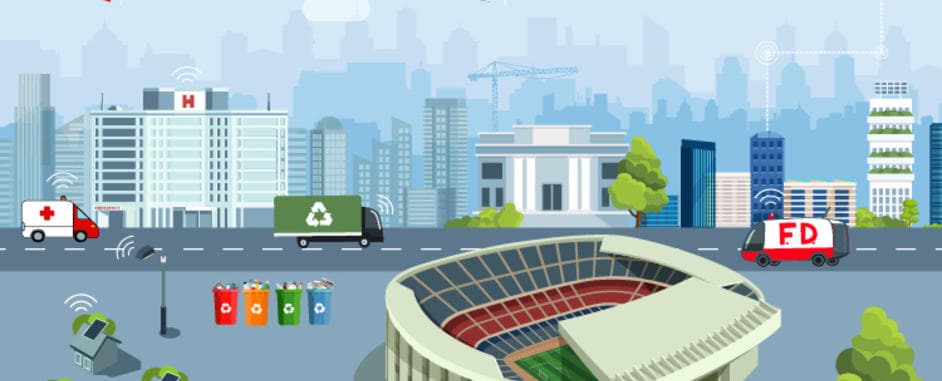
Which smart city services give more bang for the buck?
17 November 2020
At Smart City Expo World Congress in Barcelona last November, I was approached by a gentleman on the Nokia booth. He was tasked by his municipal government to define their smart city strategy. They wanted to be recognised as the flagship city in his country, and he was at the Congress to figure out how to accomplish it. No pressure! One of his very first questions was: “where should I get started with smart city, which technology will give me the best return on investment: smart parking, smart waste, smart lighting, or something else?”
This wasn’t the first time I’ve heard questions like this when engaging with city stakeholders. Beyond this anecdote, the question tells us a lot about where the smart city market stands today. After more than a decade of attempts to implement smart city initiatives, this market is still looking to define itself, trying to find a clear path to deliver truly meaningful outcomes for cities and citizens. It is still unclear for many city decision makers which strategy they should pursue to get the best outcome from their smart city efforts.
At Nokia we came to a similar market assessment. This is one reason why we felt it was important to have a deeper understanding of how those already engaged in building smart cities are actually performing. We partnered with ESI ThoughtLab to co-sponsor their 2019 hyperconnected cities market survey.
Their comprehensive study into the practices, plans, and performance results of 100 cities across the world, analyzes cities’ investments, strategies, and technologies. This was done by gathering benchmark data and conducting in-depth interviews with city leaders. They identified the hurdles that can get in the way of cities in pursuing what they call “hyperconnectivity” and how best to get over those hurdles. They even went so far as to get the return on investment (ROI) of individual smart city projects and used the results to categorize the cities according to their level of maturity, sorting them into leaders, advancers and implementers.
The calculation of ROI was done for eight key domains. The results are shown in the table below.
| City domain | Average ROI | Leaders ROI |
| Public transit | 3.4 % | 5.3 % |
| Traffic management | 3.3 % | 4.4 % |
| Water management | 3.1 % | 5.2 % |
| Energy & electricity | 3.2 % | 4.3% |
| Waste collection & Environment | 3.5 % | 5.2 % |
| Public health | 3.9 % | 5.6 % |
| Public Safety | 3.1 % | 4.5 % |
| E-governance | 4.1 % | 5.6 % |
My takeaways from the study are as follows:
- The business case for smart city is here. The investments are clearly delivering positive ROI of 3-4% on average and 4-5% for leaders. In 2019, the 100 cities surveyed reported that they will spend $141 billion on hyperconnected projects. Based on average ROI, the $141 billion investment made by the 100 cities of the study will generate a gain of $4.5 billion. This should help convince city planners, to invest in such projects, as well as other investors to join the party.
- There is no ‘killer app’ for a smart city. If e-governance services deliver a slightly higher ROI than the other domains, all of them are somehow delivering ROIs in the 3-4% range, on average (and 4-5% for leaders).
- There are multiplier effects. The leader cities see higher returns from similar projects, which suggests that the more ‘hyperconnected’ a city becomes, the greater the bang for the buck. This in turn suggests that cities should move forward on multiple fronts and plan for the long-term.
So, coming back to the initial question, rather than trying to find which single technology should be deployed in the city, cities have to think more holistically. As a starting point, clearly define what are the three or four strategic development priorities where a digital transformation could move the needle for the city and its citizens. Considering these developments together, how can a city put together a technology strategy that serves this multi-dimensional vision in a way that can scale for the whole city.
Our own ‘city as a platform’ concept, which we unveiled at last year’s Smart City Expo World Congress, has been defined precisely to support such an approach. It is based on shared technology platforms which can be deployed across the city. These end-to-end digital services should span multiple city domains, addressing, at scale, strategic city development areas and ultimately delivering better socio-economic outcomes.
This isn’t just theory, several cities we have worked with are moving in this direction. For instance, the city of Wroclaw, in Poland, has a strong vision of its priorities around four key topics: elderly and disabled people, transportation, education, and local economic development. It signed a strategic partnership agreement with Nokia a few months ago to build such a technology platform to realize their ambitions across these four domains.
Last but not least — and I will conclude with this — the value of a smart city service cannot only be measured on financial criteria. ROIs are essential for making business cases and attracting investment from community partners, but social value can also motivate city investments. This was clearly expressed in the ESI ThoughtLab study. Forty-three percent of the cities surveyed (and 52 percent of leaders) said they would undertake a project that generated no, or even negative, financial returns, if it helped achieve a greater social goal. In each of the eight domains, along with ROI, the study also captured the main social benefits that cities can expect from investing in these areas.
If you want to know more about this unique study and explore the results for yourself, please download the e-book or explore the survey data with the Data Navigator tool.
Share your thoughts on this topic by joining the Twitter discussion with @nokiaindustries using #smartcityplatform #GoAllwhere #SmartCities
This article was orignally published on Nokia’s blog.





